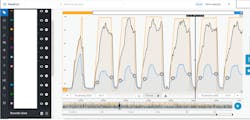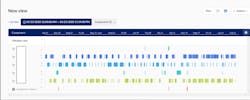About the author:
Daniel Münchrath is data analytics engineer for TrendMiner. Münchrath can be reached at [email protected].
Water is one of the most essential requirements for human health, environmental sustainability, and economic development. We cannot live without it, so we must protect the water that we have and secure it for our future.
Due to population growth, urbanization, climate change, and lack of proper water infrastructure and management, this vital resource has become more scarce in many communities around the world. In order to meet the increasing demand for clean water, the water and wastewater industry is tasked with challenging work. However, looking forward, there is a great sense of optimism and potential for what the industry can achieve when using technology such as advanced industrial analytics.
These new analytics tools put the data and the analytics in the hands of the water process experts, so they themselves can analyze their plant’s process data. With this capability, they can increase plant efficiency and optimize treatment processes thus securing water for the future.
Unlocking the Value of Facility Data
When water treatment engineers are faced with operational challenges and decide to use data to gain insights to improve processes, they traditionally turn to data scientists. There are some obstacles to this approach, however. While experts in their own right, data scientists are not always familiar with the process data itself because they are, in essence, “foreigners” to water treatment processes.
In this arrangement, there often are a lot of back and forth conversations between the data scientists and the engineers and operators who must explain how to interpret everything, all in an effort to help the data scientists accurately and effectively tackle the analysis.
Another obstacle is that the amount of data scientists available tends to be limited. So with limited resources and time-consuming frustrations, a logical conclusion is to empower the process experts with advanced industrial analytics. They are, after all, the people who know about the treatment processes and can understand the data.
As analytics users, they will be able to do the analyzes themselves, gaining fast insights into the process data, without needing to be data scientists or experts in mathematics, statistics or computer science. If the process experts can quickly access, search, and analyze the sensor generated data, they will be able to directly answer relevant questions in their day-to-day jobs at the time these questions need answering, without the delay of having to rely on data scientists. With advanced industrial analytics, process engineers and operators can:
- Visualize data to view operational behavior and anomalies;
- Use a search algorithm and pattern recognition to gain process behavior insights;
- Overlay trends for comparison to see how the process is changing over time;
- Find recommended root causes for performance anomalies;
- Set process monitors and alarms to alert process experts about potential deviations in time to take corrective action;
- Make predictions about future process behavior; and
- Incorporate process contextual information, so the entire team has a better and clearer understanding of operations.
To better understand how the water industry can use advanced industrial analytics to effectively address its challenges and maneuver into the future, reviewing some use cases can provide answers and insights.
Improved Maintenance Scheduling
The aeration elements in the biological wastewater treatment suffer from fouling effects which can decrease oxygen concentration, and the nitrogen and carbon conversion rates. Advanced industrial analytics can be used to create a clear overview of the oxygen concentration within the plant.
This overview allows the operators and engineers to constantly monitor concentrations. Using the achieved situational awareness, they can schedule the maintenance and cleaning processes at the optimal time which results in increased regulatory compliance and also reduced energy cost.
Monitoring Pump Performance
Advanced industrial analytics allow process experts to monitor their assets based on the desired operation zone, and in turn they can schedule maintenance at the right time to avoid any downtime or any unwanted process issues. They can monitor treatment processes for an increase in pressure which is a sign that there could be fouling issues.
For example, the process expert can first analyze the data to check if the deviating pressure condition led to fouling (or any other unwanted behavior). If the analysis confirms this hypothesis, the conditions can be turned into a monitor which can be set to notify the process expert or any other relevant stakeholder. By doing so, equipment costs and downtime can be reduced, and unwanted process states can be avoided.
Additional Use Cases
There are other use case examples and value drivers when advanced industrial analytics is used to analyze process data. These include reducing safety risks through early warnings, using predictive maintenance to reduce MRO (maintenance, repairs, overhauls) costs, and determining impacts of equipment and process changes. In addition, with analytics tools, process experts can facilitate monthly/yearly reports and ultimately create an active learning organization using data patterns, events and conditions.
Advanced Industrial Analytics & Substantial Improvement Potential
With an advanced industrial analytics tool, the water and wastewater industry can make the best use of its process data. Such a tool puts the data and the analytics in the hands of the people who know about water treatment — the water process experts — so they can have data-driven insights and thus make data-driven decisions. This increased analytics capability and process knowledge is the path to process optimization. Given the substantial improvement potential advanced industrial analytics can provide, the future indeed looks bright for the water and wastewater industry.


